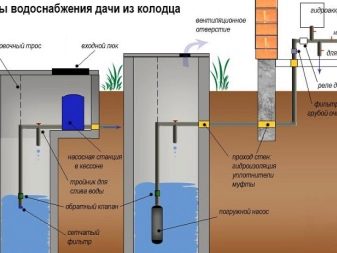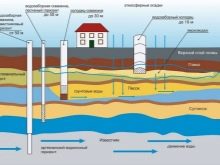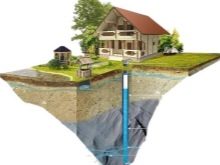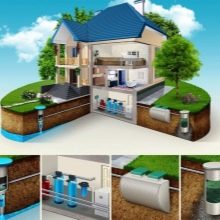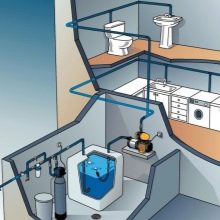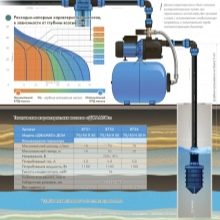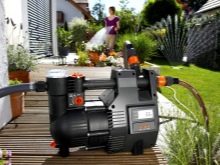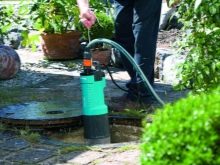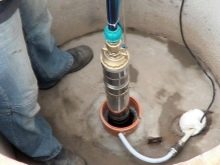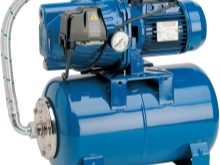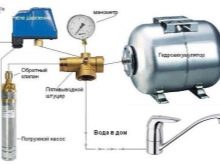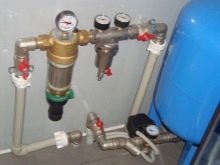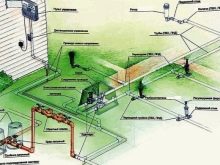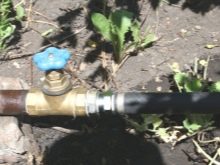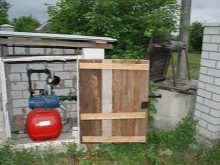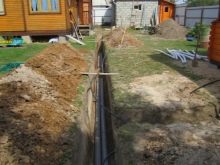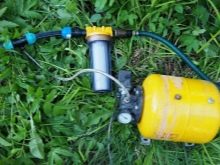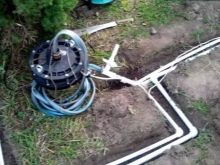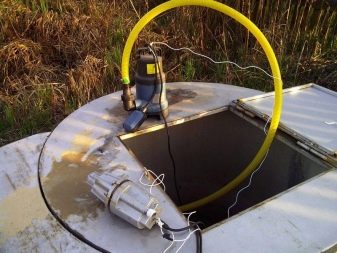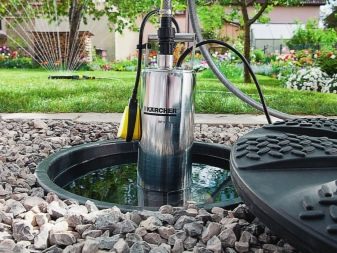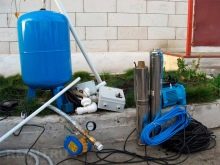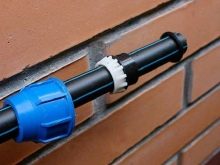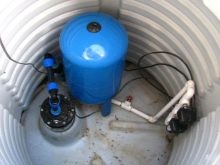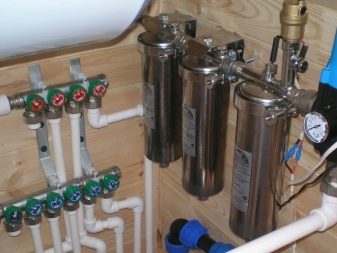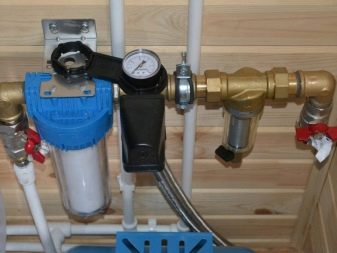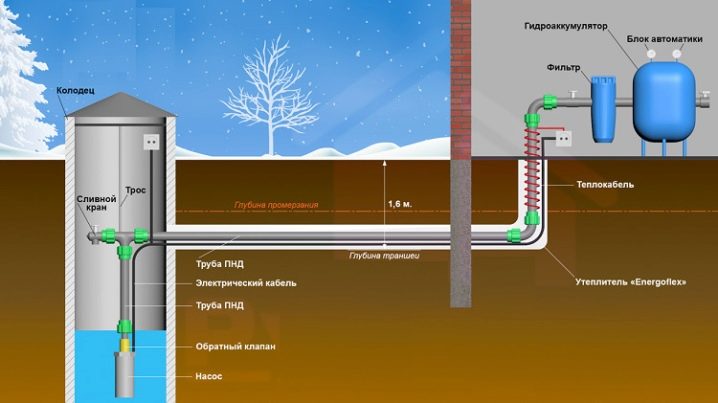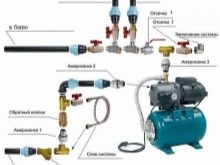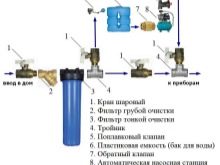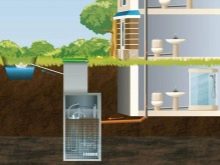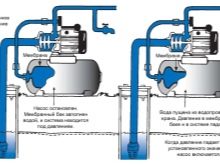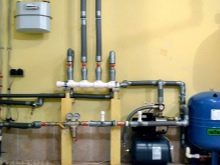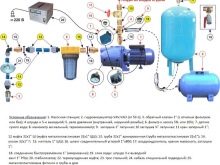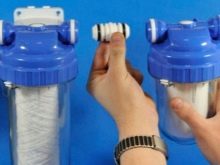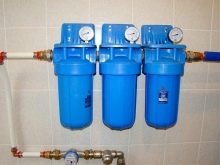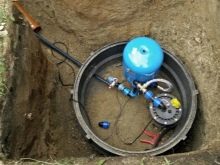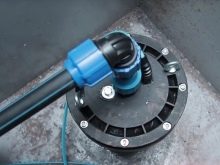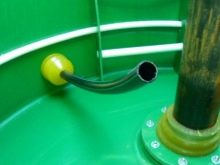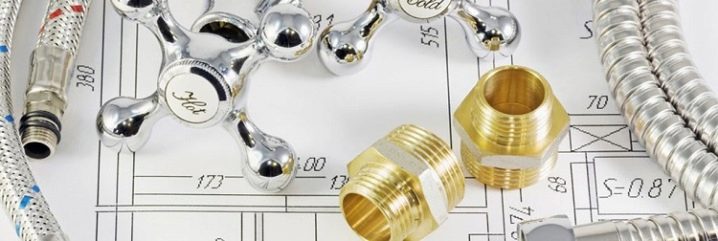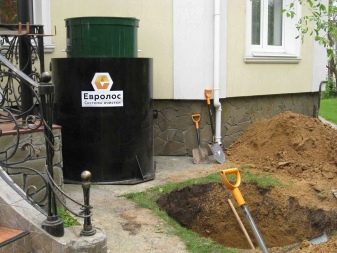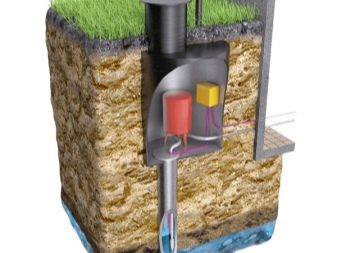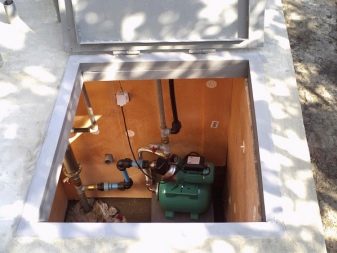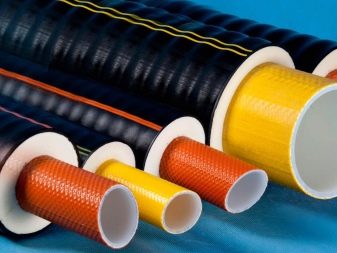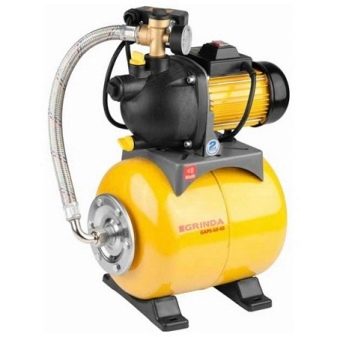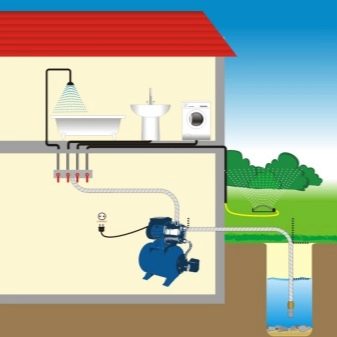Detailed scheme of water supply of a private house from a well
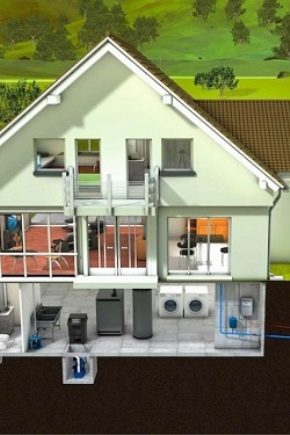
Private households are almost never connected to the central water supply. Since the use of well water has long been a more popular and affordable method of water supply. To organize it directly from the well to the house, and not to carry water in buckets, you need to find out in detail all the nuances of the process. Because a single well, hose and engine will not be enough. Let's talk about how to do it correctly and efficiently.
Special features
For an ordinary well, aquifers are often made of a non-pressure type. This is necessary due to the fact that they easily abut against the upper waterproof layer. Basically, an acceptable depth to provide water from a well for a private house is 6 to 10 meters.All that is higher, often rain or melt water, which has not yet had time to filter.
Another feature of well water is the presence of solid particles in it. This should be taken into account, since all this may further negatively affect the operation of the pump. Another factor to consider is the poor performance of many wells. It is important to remember that at different times of the year the water level may fall or rise.
Kinds
A pipeline connected from a well to a private house or cottage is not much different from other autonomous systems.
It includes:
- well as a source;
- pump;
- accumulative capacity;
- external plumbing;
- water treatment system;
- domestic water supply;
- automatic control.
There are two types of pumps that differ in the method of installation. It is superficial and submersible. There are also so-called float pumps. They are semi-submersible, as they are installed on the surface of the water. But for the water supply system in modern conditions they are practically not used.
As for surface pumps, it is optimal to install them if the height of the water lift in the well does not exceed 9 meters.It is necessary to carefully adhere to these standards, so as not to reduce the performance of equipment. There is also a limitation on water temperature. Basically it should reach at least 4 degrees Celsius. From this it follows that the surface pump is often included in the summer, rather than the winter water supply of the suburban area. Or you can install such a system already in the basement of the house. But with such an installation, the well should be at a distance of about 12 meters from the building, which will be supplied with water.
Submersible pumps can lift water to a height of about 100 meters. This does not mean that the source can be so much in depth. This suggests that this distance is required for the flow of fluid to the storage tank. Due to this capacity can be installed even in the attic of a comparatively small structure. When mounting such high-performance equipment, there is no need to install a separate water supply pump immediately. In this case, the well acts as a universal source, since it allows the use of well pumps as well.In diameter, they are much smaller, and in length much more than their counterparts.
The accumulator is an integral element of the water supply system, regardless of the type of pump to be used. Since it is here that the sensors will be installed and the automatic system that will control the on and off of the pump itself. The capacity of the hydroaccumulator is small and averages from 20 to 50 liters. This tank is not for a reserve of water and performs several important functions at once. Water that is in the hydroaccumulator will keep the system running.
Also, the presence of capacity minimizes the likelihood that a hydraulic shock can occur in the system. When choosing a model of a hydroaccumulator, it is necessary to take into account the approximate amount of water that you plan to use daily. In addition, the area of the room where the unit will be located will be important. The size of the battery and the type of installation will depend on this.
Depending on whether you live in this room all year round or use it as a summer cottage for a season, the method of laying the outer part of the water supply system depends on it.If you only come to the house in season, then you can safely choose the summer pipeline scheme. In this case, it is best to install a surface pump. Experts recommend to mount it under a canopy to protect from rain and strong sun - so that in no case is it wet. The pipes themselves, going from the pump to the building, can be laid very easily by digging out small trenches and setting the pipes to the optimum depth.
In another case, the pipe can not bury, and leave on the surface so that they do not interfere. That's only after the end of the warm months they will have to disassemble and clean the room for the winter. Also, the pipe can be brought into the room through the base or simply through the wall. Such a summer version will simplify the work, because then you will not have to make a hole in the foundation of the building.
When there is a desire to install a surface pumping station in the basement of the room, it is better to lay the pipeline according to the winter scheme. The advantage of this scheme is that it will not be necessary to drain the water regularly. And in the cold season, the whole system will endure frosts well.
Device
The pipes from the well to the cottage or the house are mainly carried out already when the well is already functioning smoothly on the land plot.
The scheme of autonomous water supply through the pipeline to the house consists of:
- digging trenches for pipes;
- laying the pipeline;
- selection of the optimal pump;
- pump installation;
- install filters.
You will also need detailed development of a water supply plan. The pipes themselves can be made of various materials. The optimum are metal, plastic, copper, cast iron. The most important element in the water supply scheme is the pump. You can install it directly in the house or above the well.
It is desirable that the pump was in a warm room, but if it will be located on the street, then it should be wrapped up for the winter. The pump pumps water that passes through the pipes and into the hydroaccumulator. After that, the water disperses in all the necessary places in the house.
The pump is also installed in the well. This can be done in two ways. In the first case, you first need to drill a hole on the side of the second or third ring. After that, pass a plastic hose into this hole, on which an already mounted pump should be lowered into the well so that it does not reach 30 centimeters to the bottom.An electrical cord must be inserted through this hole. In the second version, the pump hose, which will pump the water, is fixed directly in the well itself. This method is considered more simple to perform and as convenient as possible. As with such an installation, the pump can be easily reached if necessary.
With regard to the supply of water to the house, autonomous water supply schemes may vary significantly. It depends on whether it is seasonal use of the well or permanent. Both in one and in the second embodiment, the pipe diameter must be at least 32 millimeters. Piping should be at an angle to the well. Through each meter, the angle must be exceeded by 15 centimeters. If this is a seasonal water supply system at the dacha, then it will be necessary to equip the faucet through which the drain will be made. To one of the water pipes you need to attach a tee into which the input pipe is made. It is in this case and will serve as a drain.
If the pipeline supplies water all year round, then it must be installed deeper. To prevent the pipes from freezing in winter, the average trench depth should be about 2 meters.
Materials and tools
Not every private house is connected to the central water supply system, besides steel highways are often rusty and the water that flows through them is not at all suitable for drinking or domestic use. For this reason, many homeowners are doing plumbing to the private sector through a well or well today. At first glance it may seem that these works are very laborious and costly, but with the right approach and well-planned work, the whole event will take very few resources.
To bring the water pipe from the well to the house, you will need properly selected pipes in size and composition. Experts recommend using modern materials because of their high quality. Ideal options are made of polyethylene, for example, with a wall thickness of 3 millimeters, which is best suited for laying water supply for the summer cottage or the private sector. To perform external wiring used pipes with a diameter of 32 millimeters.
In addition to pipes, a rather large amount of materials is also required for laying water pipelines.In addition, different layouts require different equipment. For the most common scheme of water supply from a well (using a submersible pump), parts such as a borehole adapter and a suspension cable with a diameter of approximately 3 millimeters are used. You will also need to purchase the pumping device itself, where the check valve is pre-installed.
The next item in the list of necessary devices is the hydroaccumulator. For this purpose, suitable device with a capacity of 25 to 100 liters. To control the work of the submersible pump or station, you will need a relay. It would be best to purchase an RDM-5 device operating on the dry run. Also, to exercise effective control over the operation of the pump, you will need a pressure gauge.
To clean the water entering the house, you will need to buy both coarse and fine filters. In addition, you will need to purchase ball valves and fittings. In order for the entire system to function durably and smoothly, it will need to be connected to the electrical network, which can be done with a conventional electrical cable and switch with a nominal value of 16 amps.
How to do?
The flow of water from the well into the room can be provided both exclusively in the summer and on a regular basis during each season. To prevent the water from freezing due to the winter cold, it is reasonable to run the water supply directly under the ground. There are several options for self-improvement of the water supply system, which do not require substantial labor resources or material investments. Nevertheless, even during such work one may encounter a number of difficulties, the main of which is the correct fit of the hose to the sides of the ring where the hole is made.
In order to prevent surface waters from contaminations from falling into the well, the docking point is insulated by means of a special composition that must be made of cement and liquid glass. When in the country or in a private house there is a constant water supply - it is very comfortable for residents. However, to hold the water at home and do it correctly, you will need to work hard.
In addition to a number of building materials and tools, certain skills and theoretical knowledge will be needed. The main ways to ensure uninterrupted supply of water include the flow through a pumping station, through special tanks or using a hydraulic tank.Proper organization and configuration of such water supply will allow you to get excellent water pressure in the tap.
To begin with, the room will need to allocate a place where the pump will be installed. For this purpose, a small pantry is perfect - such a room is not so difficult to remake for the necessary needs. Next, usually proceed directly to the device water supply system. First, you need to lower the pipe in the well to draw water at a distance of about half a meter from the bottom. One end of this pipe is closed with a special filter made from a special mesh - it will clean the water from all kinds of garbage.
It should be noted that the filter sometimes needs to be cleaned. Don't be scared - it's pretty easy to do. If a metal pin is mounted on the bottom of the well, the cleaning hose is attached to it, otherwise it is done in any convenient way.
Before the pumping station, it is required to connect a non-return valve and a filter system for coarse cleaning. Following the pump is mounted filter for fine cleaning. This installation procedure is dictated by the fact that the device should not receive particles of dirt,because they are able to simply break it. Installing a valve requires that water does not flow back to where it came from.
Such a system requires constant monitoring, and therefore the installation of equipment such as a pressure switch and pressure gauge is required. After connecting the entire complex water system, these devices will need to be properly configured.
Subject to all the rules of connection to supply water to the house will not be easy. Such a homemade system works extremely efficiently. However, there are a number of nuances and subtleties that make water supply wiring even easier. In many cases, the installation of pumps can be carried out directly above the well or well, for which all equipment is installed in a special container - the caisson. This method of supply is very popular. First, you need to dig the pipe to a depth of 2.5 meters, and the diameter of the pit should be 2 times larger compared to the caisson. At its bottom, a standard concrete solution is poured with a layer of 20 centimeters, after which the caisson is placed there.
The pipe is cut so that its end is above the caisson about another half a meter. Then you need to dig a trench about 2 meters deep. After that, you can proceed to the installation of the pump and connect it to the plumbing system. And, finally, at the final stage, with your own hands, you need to pour the caisson with a solution of concrete along the contour and cover all the above with earth.
Tips and tricks
Creating a water supply system from a well or a well in a private household requires a number of preparatory work, some of which are quite large-scale. Such measures include the arrangement of a well with a waterproofing system or the drilling of a water well with the installation of a casing pipe. Also, in some cases, it is possible to install a special tank that will be underground - water is supplied to such a storage, which can then be fearlessly drunk. All of the above options are well combined with a water supply scheme, including a pumping station with a relatively small capacity.
It should be noted that during the first start-up of water supply to a private house from a well in a system that was made on its own, various malfunctions are possible.Naturally, it often happens that the water supply system is running almost perfectly, then there will be no problems, but mistakes can happen to everyone. Thus, when launching the system for the first time, it is necessary to closely monitor how it works, for which it is necessary to check how it functions at home. First of all, you need to closely monitor such an important indicator as pressure.
If there is a clear flaw in it, then, most likely, there is a leak somewhere that will need to be found and fixed. For this reason, experts do not recommend bury the trench before the first start of the water supply, because in this case it will be extremely difficult to find the leak and repair it.
When it seems that the pipes are not buried deep enough to ensure uninterrupted water supply during each season, they can be additionally insulated with materials such as mineral wool. Then the water will be supplied to the premises almost year-round. In addition, you can arrange the flow of hot water from the well to solve this urgent problem once and for all. Beyond the city limits in households, hot water supply is most often done with the help of solid fuel boilers.
In the overwhelming majority of cases, the autonomous water supply from the well to a private house is seasonal due to the fact that the pipe from the well goes directly to the surface. Accordingly, it is necessary to mount the pipeline in such a way that it is located underground at a depth of at least about one and a half meters. It is also important to remember that if the water in the pipes freezes, and the pump does not have protection against dry running, then it can simply fail.
How much an independent water supply system will be effective depends largely on the pressure indicator in the system. Whether the water is taken from a well or from a well, but the water supply system, in any case, must be arranged in such a way that there is a good pressure from the tap. Sometimes it happens that there is simply no possibility of ensuring the correct pressure and, consequently, a good pressure of tap water. Then you can use pressureless tanks, powered by electricity. However, such equipment is sometimes difficult to combine with such household appliances as a washing machine or dishwasher.
The quality of water from such sources is enough to water the garden. Moreover, the first filtration stage provides sufficient cleaning to wash the car with such water without fear of damaging the paint. But so that the well could be drunk fearlessly and used for cooking, it is necessary to bring it separately to its impeccable quality.
The main problem is that the chemical and bacterial composition of water from a normal, not very deep well or well is extremely unstable. Back in the 50s of the last century, most well owners did not think about whether to drink well or not to drink well water, because the upper layers of the soil and, accordingly, water were not yet so badly damaged by human activity. Today, water from wells, especially if they are located not far from cities, can be drunk with great caution.
In modern conditions, even 15 meters of land will not filter the water well enough for its natural purification. Even when the site with the well is located at a considerable distance from megacities and industrial zones, the composition of rivers and precipitation will influence the chemical composition of the water. For this reason, a water supply system connected to a not very deep well or well requires regular correction and adjustment of filters installed in the water treatment system.
Following all points of the plan and observing all the rules, even a simple man in the street who does not have professional knowledge will be able to arrange an autonomous water supply from a well. Such a system may well provide uninterrupted delivery of hot and cold water to any room, be it a small country house or a large country cottage.
The following video shows in detail the water supply of a private house.
